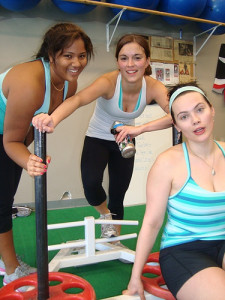There are four basic types of fitness most people are concerned with: cardio, muscular, movement and flexibility.
Cardio Fitness
Cardio fitness refers to the capacity and strength of your heart and its ability to work, along with your lungs, in conjunction with your physical activities. Your heart is a muscle, and the more you use it, the strong it becomes. You want to improve your cardio fitness in three ways: strength, stamina and recovery. Cardio strength refers to how much work you can do at one time, or how many times your heart can beat one time per minutes. Stamina means you can work at higher levels (or a higher heart beat) for longer periods. A sprinter might have more cardio strength than a marathon runner, but the marathoner can run longer. Cardio recovery means that you can lower your heart rate quickly after an intense bout of activity, such as after a tennis, basketball or volleyball point.
Strength – An example of improving your strength would be exercising at a high heart rate, such as doing sprints.
Stamina – An example of improving your stamina would be a beginner exerciser moving from a 15-minute, brisk walk to 30 minute of more exercise. You improve your stamina with aerobic exercise.
Recovery – An example of improving cardio recovery would be your ability to recover after a tennis point, football play or basketball fast break. You improve your stamina with anaerobic exercise, or interval training.
Muscular Fitness
Muscular fitness refers to the amount of work your muscles can do (strength), the amount of time you can use them (endurance) and the types of movements you can do (powerful, quick, fast).
Strength – An example of strength would be your ability to lift a weight or move an object. You have more strength if you can lift 100 pounds than if you can only lift 50 pounds. Muscle strength is not only good for work and sports — strong muscles help prevent back problems by helping support your spine and stomach weight.
Endurance – The longer you can perform an activity, the more endurance you have. If you can go from a 30-minute workout to a 45-minute workout, you’ve improved your muscular endurance.
Muscle Fibers – Your muscles have high-twitch (fast) and low-twitch (powerful) fibers. You can train your muscle fibers, depending on whether you want to be more powerful, quicker, or both. You do this with specific exercises that help build limit, explosive and reactive power. Aerobic exercise trains your low-twitch muscle fibers, so save this type of exercise for the offseason if you are an athlete. Anaerobic, or interval training, will maintain your aerobic base during the season, and train your fast-twitch muscle fibers.
Movement
Whether you are an athlete, senior or somewhere in between, your ability to perform physical activity with balance and agility is important. Known as neuromotor skill, this type of fitness helps you around the house, at the office or during sports. Avoid only doing repetitive-motion workouts to help improve your footwork, balance and agility. Activities as simple as hop-scotch or jumping rope with different footwork can help you improve your neuromotor skills.
Flexibility
Flexibility helps you do more during the day, create better workouts or play sports with more success. One of the most important activities seniors can do as they age is to spend 5 to 10 minutes stretching each day. You’ll get more power on your golf or tennis swing if you can take the club or racquet back farther — this is an example of flexibility. Don’t perform traditional stretching before activity — this will cause a decrease in power and jumping ability for 15 minutes or longer. For more on how to stretch before and after sports or exercise, check out our article on the Myth of Stretching.
Additional Resources
American College of Sports Medicine: Recommendations on Quantity and Quality of Exercise
Mayo Clinic: 7 Benefits of Regular Physical Activity
Centers for Disease Control and Prevention: How Much Physical Activity do Adults Need?
Mayo Clinic: Fitness Training: 5 Elements of a Rounded Routine
